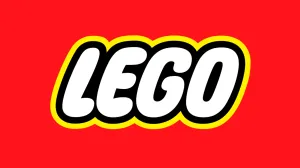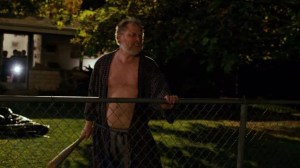
Marvel’s Original Sin continues this week with its penultimate chapter. So far, the series, and its crossover issues, has offered readers a dramatic roller-coaster of a story filled with plenty of shocking reveals and double crosses that could potentially have some long-term effects on the Marvel Universe. It also has inspired some of us here to reflect and rank some of the biggest, most shocking character turns in comic book history.
Videos by ComicBook.com
Fortunately, there are plenty of fantastic “heel turns” (as they would say in the pro wrestling business) to talk about when it comes to the world of comics. Just like any other long-term serial medium, sometimes a creator needs to mix things up with a character in order to keep things fresh and interesting for readers. If mixing it up involves the murder of innocent people, or the betrayal of a fan favorite character, then so be it.
This list aims to look at those comic book heel turns that have had the biggest affect on the industry, either in terms of being a part of critically or commercially successful stories, or by serving as inspiration for future creators who were looking to break the hearts of their readership by turning a revered character to the dark side.

10. Ultimate Black Widow
In a unique twist, the Ultimate Universe’s depiction of Natasha Romanoff, aka, the Black Widow, flips the mainstream, Earth-616 version of the character on its ear. Whereas the original Black Widow debuted as a villain in Tales of Suspense #52 before eventually going “straight,” in The Ultimates, she is one of the “good guys,” before she betrays her teammates in epic fashion.
Ultimate Natasha leaves quite a path of destruction in The Ultimates 2, before she is eventually killed off by a revenge-bent Hawkeye. She publicly outs Bruce Banner’s identity as the Hulk, frames both Thor and Captain America, joins the anti-American group The Liberators and then coldly murders Hawkeye’s wife and children while he watched. She also holds her then-fiancée Tony Stark hostage, killing his servant Jarvis and attempting to extort him for his fortune, before Tony manages to freeze the nanites in her bloodstream and cold cocks her with a wine bottle. But before that satisfying blow, Natasha does get a pretty cool moment when she mocks Tony’s outrage for her heel turn, telling him, “Oh please. The Russian spy? I can see why you think I’d be the last person to betray America’s premiere defense force.”
Burn…
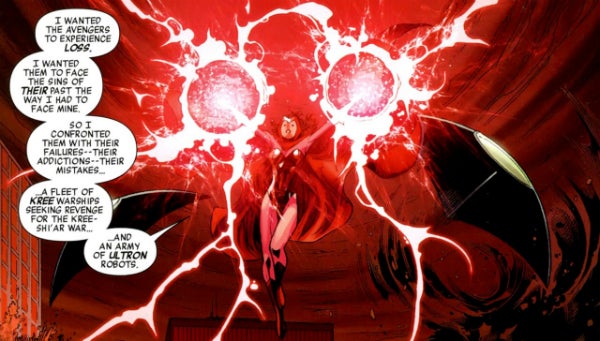
9. Scarlet Witch
Wanda Maximoff, better known by her alias, Scarlet Witch, is an interesting case in that the character was originally introduced as a heel (as a member of Magneto’s Brotherhood of Evil Mutants in Uncanny X-Men #4), before joining “Earth’s Mightiest Heroes,” the Avengers about a year later (she was recruited with other one-time villains Hawkeye, and her brother Quicksilver).
While Wanda has been involved in plenty of questionable moments over the years, her full-blown heel turn was saved for the “Avengers Disassembled” Avengers arc in the mid-2000s. In this story, Wanda attempts to resurrect her children by seeking out help from Doctor Doom. When a cosmic force mergers with her, she loses all connection with reality and blames the Avengers for the death of her kids. Her former husband, Vision, and her longtime friend Hawkeye are both killed during Wanda’s massacre.
Wanda then ratchets the heel turn up another notch about a year later for House of M. In this Marvel event, Scarlet Witch creates an alternative reality that seemingly fulfills everyone’s wishes. Eventually, Marvel’s assembly of heroes realize that something is seriously wrong, forcing them to confront Scarlet Witch, Quicksilver and their father Magneto. When Magneto seemingly kills Quicksilver for urging Wanda to create this alternative reality, Wanda snaps again, depowers Magneto and about 90 percent of the world’s mutant population with the words “no more mutants,” and resurrects her brother.
Perhaps, it could be argued that Wanda’s House of M turn was more of a “tweener” move rather than a full-blown heel beatdown.

8. Alex Wilder
Coming as a true shock in Brian K. Vaughan’s beloved first volume of Runaways, Alex Wilder, the leader of a gang of teenagers who band together after discovering that their parents are secretly supervillains, betrays his teammates and reveals himself to be a mole in the group. In typical Vaughan fashion, he builds Alex up as a likeable kid who is finding himself in the world once he’s away from his evil parents, only for the character to be callously yanked away from readers because nobody can have nice things in a Brian K. Vaughan story.
But at least readers get the satisfaction of watching the young Alex get incinerated by the Gibborim – a mythical entity that the group’s parents is trying to please by sacrificing innocents in order to get a seat in “paradise.” That is, if watching teenagers get turned into ash is your idea of a good time.
After appearing from a “white void” in the second volume of the Runaways, Wilder was resurrected in full this year in an issue of Avengers Undercover.
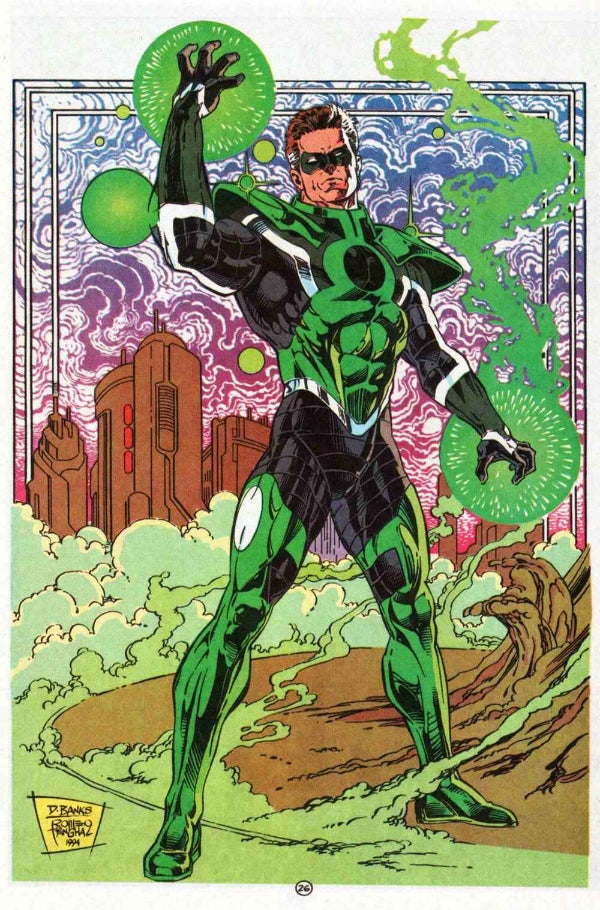
7. Hal Jordan
In probably one of the more controversial heel turns in comic history, Hal Jordan gets his “90s moment” during the “Emerald Twilight” storyline (aka, the moment nearly every hero was subjected to during the decade which ended up blowing up the current status quo in traumatic fashion – see also, “The Death of Superman,” “The Clone Saga,” and “Knightfall”). During this storyline, Hal becomes distraught when his former home, Coast City, has been destroyed by Cyborg Superman in the “Reign of Superman” storyline.
Hal goes nuts seeking revenge from those who destroyed Coast City, only to get a stern finger wagging from the other Guardians for using his power ring for personal gain. This Guardians’ behavior sends him further over the deep end, so Hal snaps the neck of his old-time rival Sinestro, kills his onetime friend Kilowog, and then enters the Central Battery, coming out as the supervillain Parallax.
Hal would eventually be replaced by Kyle Rayner in the Green Lantern series, while Parallax would go on to cause trouble as part of 1994’s Zero Hour event. Jordan would later become another incarnation of the Spectre, before Geoff Johns restored the Silver Age status quo with his Green Lantern: Rebirth series in the mid-2000s, resurrecting Hal and making him the Green Lantern again.

6. Kid Miracleman
Comic book readers can fortunately now get their fix of these once hard-to-find comics after Marvel acquired the license to the Miracleman property late last year. But those who followed Alan Moore and Gary Leach’s Marvelman/Miracleman stories when they were first published independently in the early 1980s, should be quite familiar with the dark character turn for Miracleman’s one-time kid sidekick, Johnny Bates.
When Bates first appeared in the Mick Anglo Marvelman comics in the 1950s, he was your standard superpowered teenage sidekick. Once Moore was in charge of the character, Bates had evolved into a violent, sociopathic businessman, who harbors an unsettling hatred for his former partner. In their first encounter, Bates murders his secretary in front of Miracleman and nearly beats the hero to death, before his own hubris got in the way and he accidentally said the word, “Marvelman,” transforming him back into his de-powered persona. Bates is held in custody, but eventually escapes and rampages through London, killing a big chunk of the city’s population.
While the Miracleman/Marvelman series didn’t achieve the widespread popularity of some of the other comics on this list, Kid Miracleman’s heel turn is notable for just how extreme of a character shift it ended up being. Think Bucky Barnes becoming the Winter Solder about 25 years earlier, and if he was more in control and responsible for his actions. Speaking of which …

5. Bucky Barnes
As the old saying go, nobody stays dead in comics except for Uncle Ben, Jason Todd and Bucky. Except that the latter two have since been resurrected and in Bucky’s case (actually, Jason Todd too), the character was brought back as a supervillain and adversary for his one-time partner, Captain America.
Bucky’s heel turn is an interesting case because it can be argued that he wasn’t in complete control of all of his facilities, and thereby may not be totally responsible for his actions. But a mindset like that would completely ruin the fun of a list like this that looks at the most memorable times a good guy went bad, right?
In all seriousness, after the explosion that presumably kills Bucky (that Cap recaps in his Silver Age debut in Avengers #4), we learn that he was actually frozen in the water below and recovered by the Russians. Bucky is then rehabilitated and reprogrammed into a Soviet assassin. When he is confronted by his old friend Captain America during the famed Ed Brubaker/Steve Epting arc, “The Winter Soldider” (you might have heard of some movie based on this story), Bucky comes to his senses long enough to destroy the Cosmic Cube. He would later be recruited by Tony Stark to become the new Captain America after Cap’s death at the end of Civil War (more on that in a second).
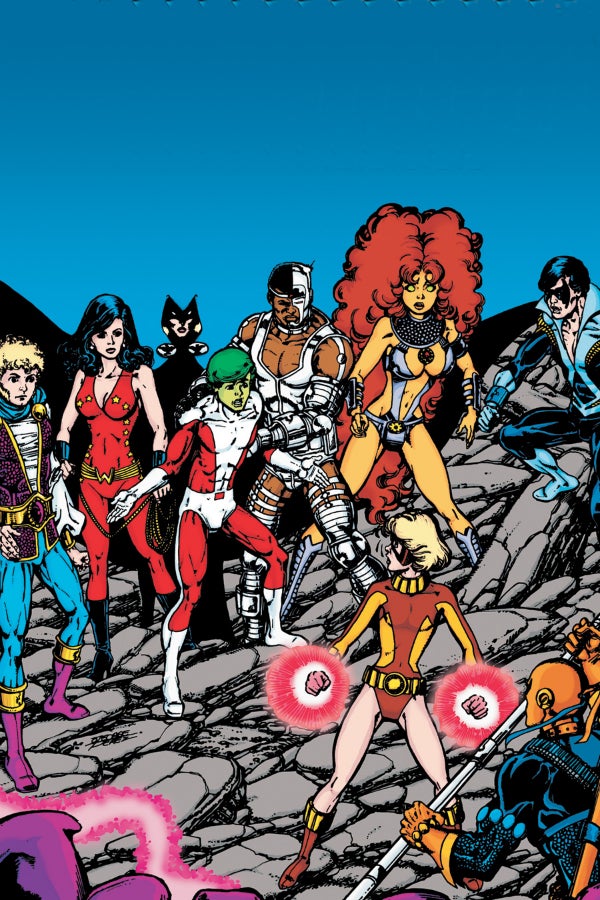
4. Tara Markov
In one of the most famous stories from one of the most popular series of the 1980s, Tara Markov, aka, Terra, betrays her New Teen Titan teammates in the appropriately titled “The Judas Contract” arc.
In this storyline, Terra, who had joined the teenage supergroup a handful of issues earlier, reveals that she’s actually a hired mercenary working for Titans villain Deathstroke the Terminator. She spent her time infiltrating the Teen Titans at every level, learning their identities and scheduled whereabouts so she could eventually sell the team out to Deathstroke. All but Dick Grayson, who assumes the identity of Nightwing for the first time in this storyline, are captured by Terra and Deathstroke, but the group is ultimately rescued by Grayson and Deathstroke’s son, Jericho.
The reversal of fortune causes Terra to lose her marbles, as she attempts to use her very potent geokinetic powers against both the Titans and Deathstroke. She ends up killing herself when she brings an entire complex down upon herself.
In a unique twist, the Teen Titants keep Tara’s heel turn a secret from the outside world, and erect a memorial statue of her in her honor.

3. Adrian Veidt
In a heel turn that makes the reader think (what else do you expect from an Alan Moore comic that’s notorious for the way it deconstructs the superhero genre?), Adrian Veidt, aka Ozymandias, turns on his Watchmen teammates, even killing one, all in the name of carrying out a plan of mass genocide that would leave millions dead, but also save billions from the ramifications of an imminent nuclear war between the United States and the Soviet Union.
Or in short, Ozymandias kills the Comedian, frames Dr. Manhattan, and then sends a telepathic squid creature to New York City, which explodes and kills millions, but causes the U.S. and the Soviet Union to band together against a common enemy (an extraterrestrial squid monster).
Maybe that second explanation wasn’t much simpler.
Regardless, Ozymandias perfectly emblemizes the age-old philosophical debate, “do the ends justify the means.” Ozymandias betrayed his friends and killed millions of innocents, but his actions resulted in world peace. He also got one of the coolest, and most memorable heel turn moments in industry history when he announces his intricate plan to his surviving teammates and as they’re trying to convince him to reconsider, he coldly tells them, “I did it 35 minutes ago.”

2. Tony Stark
Tony Stark had always had a cocky, self-absorbed streak that led to him having a hard time playing along with others, but he became the poster child for the modern era heel turn when he came out in support of the Superhuman Registration Act, leading to the onset of Civil War.
It’s important to note that Stark did not act by himself, as he had a number of high-profile allies on the Pro-Registration side, most notably Reed Richards of the Fantastic Four and Hank Pym. But as the de facto leader of the group, Stark was the firebrand and the chief antagonist for Captain America and his “Secret Avengers,” who, for all intents and purposes, were the “heroes” of the epic Mark Millar/Steve McNiven story.
At one point in Civil War, Danny Rand, who was pretending to be Daredevil in place of Matt Murdock, threw a silver dollar at Stark’s feet, a reference to Christianity’s most famous traitor, Judas Iscariot.
When Captain America surrendered and Marvel’s Civil War ended, Stark had Cap paraded around in public, which opened the door for Cap’s assassination. That’s when Stark realized the error of his ways and he famously told Cap’s corpse that the whole war “wasn’t worth it.”

1. Jean Grey
You can’t really talk about heel turns without accounting for one of the most memorable character turns in comic book history (and one of the greatest stories of all-time, period). During the famed Chris Claremont/Dave Cockrum run on Uncanny X-Men in the late 1970s, Jean Grey, one of the original members of the Silver Age X-Men, appears to have died in a crash, before bursting out of the Jamaica Bay wearing a new costume and sporting a highly augmented powerset. And thus, the Phoenix was born.
Of course, the Phoenix force would ultimately corrupt Jean, leading to the Claremont/John Byrne classic, “The Dark Phoenix Saga.” At one point, Jean wipes out an entire planet in order to “feed” the cosmic force that has possessed her, and she also fights with her teammates before she is apparently turned back to the side of good. However, when the Phoenix force makes one last stab to posses her, Jean commits suicide in the storyline’s traumatic final chapter.
Jean would be resurrected and killed off a few times since “The Dark Phoenix Saga,” while the Phoenix force itself has been used as a plot device for countless Marvel tales. However, Jean’s actions during the “Dark Phoenix” heyday have led to an interesting debate among fans and critics about whether or not her evil behavior was innate or if it was instead a byproduct of a greater cosmic force controlling her.



